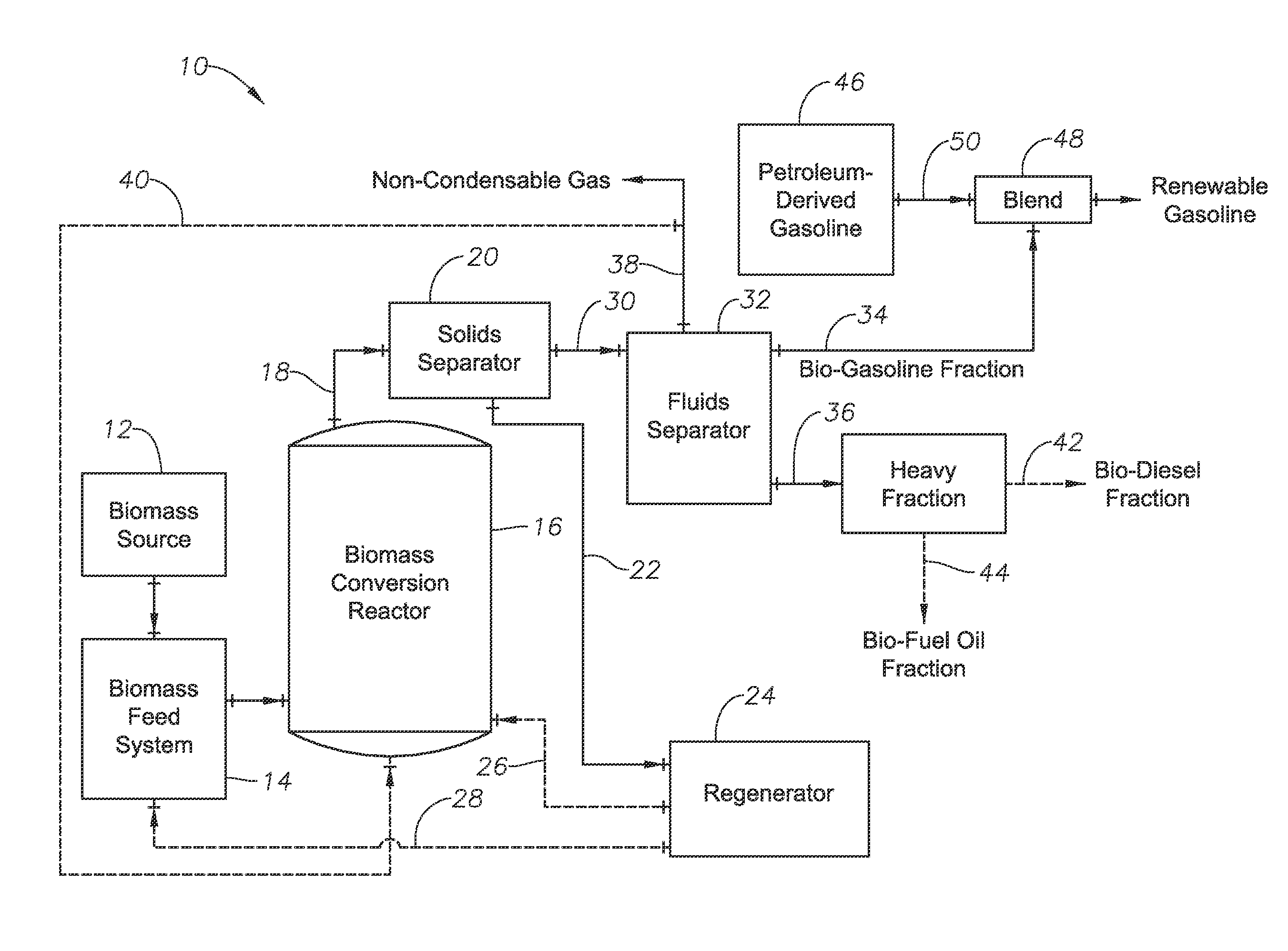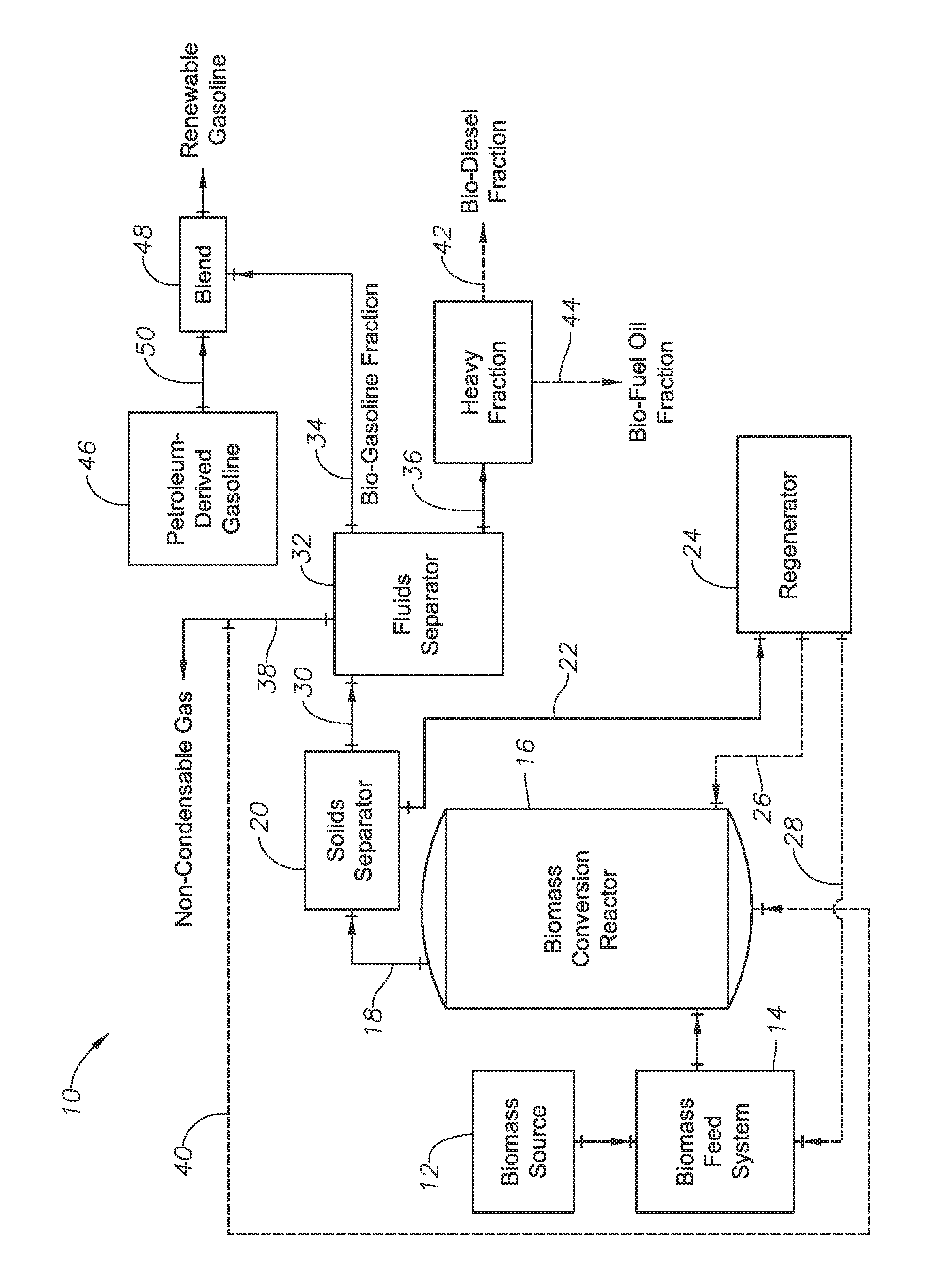Production of renewable bio-gasoline
a bio-oil and gasoline technology, applied in biofuels, fuels, fatty acids chemical modification, etc., can solve the problems of difficult, if not impossible, to separate into various fractions of low-quality bio-oils containing high amounts of oxygen
- Summary
- Abstract
- Description
- Claims
- Application Information
AI Technical Summary
Benefits of technology
Problems solved by technology
Method used
Image
Examples
example 1
[0043]A low oxygen bio-oil was produced from the conversion of southern yellow pine wood particles by pyrolysis in the presence of a catalyst in a riser reactor operated at a reactor outlet temperature of 640° C. The resulting bio-oil had an oxygen content of 12 weight percent, and was distilled to yield more than 25 weight percent of a bio-gasoline fraction boiling in the range of less than 215° C. The composition of the bio-gasoline fraction is shown below in Table 1.
[0044]
TABLE 1wt %Cyclics / AromaticsCyclic dienes0.00BTEX16.94Other 1-Ring Aromatics11.96Indanes / Indenes13.42Naphthalenes5.943-Ring0.004-Ring0.005-Ring0.006-Ring0.00Total48.26Nitrogen CompoundsIndazoles0.00OxygenatesAlcohols0.00Ethers0.00Carboxylic Acids0.00Aldehydes0.00Ketones0.39Phenols43.40Diols0.00Indenols0.00BenzoFurans7.95Naphthols0.00Levoglucosan0.00Total51.74Total [0] (%)12.00Total [S] (ppm)23.17
[0045]As can be seen from the data, the bio-gasoline fraction is of high quality, having a low oxygen content, undetec...
example 2
[0046]Quantities of the bio-gasoline fraction from Example 1 were blended with conventional petroleum-derived gasoline having an AKI of 87.7. The AKI was determined for the various blends, and the results of the blending are reflected in Table 2 below.
[0047]As can be seen from Table 2, the addition of the bio-gasoline fraction acts as an octane booster for the resulting renewable gasoline blend.
[0048]
TABLE 2Volume % Bio-Gasoline Fractionin Renewable Gasoline BlendAKI Value188.05288.45489.2
example 3
[0049]Quantities of the bio-gasoline fraction from Example 1 were blended with conventional gasoline. The conventional gasoline and the various blends were tested for various properties / components. The results of such tests are reflected in Table 3 below.
[0050]
TABLE 3SpecificationTest MethodValue / RangeRenewable gasolineBiogasoline, vol % in Blend15Oxygen in biogasoline, wt %1512Sulfur, ppm (max)D 1266, D 2622,801518D 3120, D 5453,D 6920, or D 7039.Benzene, vol % (max)D 360610.500.57Oxygen, wt %(max)D 4815, D 5599,2.70.070.35or D 5845.RVP, psi (max) WinterD4953, D 5190,13.510.08—D 5191, D5482,or D 6378.Oxidation Stability, (min)D 525240>240>720Solvent-washed GumD 38155Content, mg / 100 mL, (max)Copper Strip Corrosion, (max)D 130No. 1No. 1No. 1
[0051]As can be seen from Table 3 above, the blending properties of the bio-gasoline / conventional gasoline blends are overall significantly improved with the use of a lower oxygen content bio-gasoline fraction blend stock.
PUM
| Property | Measurement | Unit |
|---|---|---|
| weight percent | aaaaa | aaaaa |
| weight percent | aaaaa | aaaaa |
| weight percent | aaaaa | aaaaa |
Abstract
Description
Claims
Application Information
 Login to View More
Login to View More - R&D
- Intellectual Property
- Life Sciences
- Materials
- Tech Scout
- Unparalleled Data Quality
- Higher Quality Content
- 60% Fewer Hallucinations
Browse by: Latest US Patents, China's latest patents, Technical Efficacy Thesaurus, Application Domain, Technology Topic, Popular Technical Reports.
© 2025 PatSnap. All rights reserved.Legal|Privacy policy|Modern Slavery Act Transparency Statement|Sitemap|About US| Contact US: help@patsnap.com


